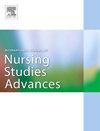中国老年慢性心力衰竭患者自我护理行为轨迹及其影响因素:一项前瞻性观察研究
IF 3.1
Q1 NURSING
International Journal of Nursing Studies Advances
Pub Date : 2025-09-07
DOI:10.1016/j.ijnsa.2025.100418
引用次数: 0
摘要
自我护理对改善慢性心力衰竭患者的生活质量至关重要。自我照顾行为随时间而改变,不同特征的患者的轨迹不同。然而,老年慢性心力衰竭患者的自我护理行为轨迹尚未得到充分研究。目的探讨中国老年慢性心力衰竭患者出院后3个月的自我护理行为轨迹模式及其影响因素。方法前瞻性观察研究于2022年10月至2023年7月在中国上海某三级医院招募了255名老年慢性心力衰竭患者。在基线、出院后2周、4周、2个月和3个月,使用有效的问卷和电子健康记录调查人口统计学和临床信息、自我护理行为、自我护理信心、疾病感知、自我效能感、社会支持和心力衰竭知识。采用生长混合模型识别自我照顾行为的轨迹模式。采用Logistic回归分析确定不同轨迹模式的影响因素。结果最拟合生长混合模型揭示了自我护理维持的2级模型:“持续良好”组和“差-逐步改善”组;症状感知三级模型:“逐渐减少”组、“持续差”组、“差-逐渐改善”组;自我护理管理的三级模式:“差-逐渐改善”、“持续良好”和“早期提升后下降”组。自我护理信心、心力衰竭知识、经济水平和医疗费用来源是影响自我护理行为不同轨迹模式的决定因素。结论本研究提高了对中国老年慢性心力衰竭患者不同的行为轨迹模式及其影响因素的认识。应针对不同群体的独特需求制定量身定制的干预措施,以维持令人满意的自我保健行为。本文章由计算机程序翻译,如有差异,请以英文原文为准。
Trajectories and influencing factors of self-care behaviors in Chinese older adults with chronic heart failure: A prospective observational study
Background
Self-care is crucial for improving the quality of life of patients with chronic heart failure. Self-care behaviors change over time, and the trajectories differ among patients with varying characteristics. However, the trajectories of self-care behaviors in older adults with chronic heart failure have not been fully studied.
Objective
This study aimed to identify the trajectory patterns of self-care behaviors over 3 months after hospital discharge in Chinese older adults with chronic heart failure, as well as the factors influencing these patterns.
Methods
A prospective observational study was conducted from October 2022 to July 2023, involving 255 older adults with chronic heart failure recruited from a tertiary hospital in Shanghai, China. Demographic and clinical information, self-care behaviors, self-care confidence, illness perception, self-efficacy, social support, and heart failure knowledge were investigated using a validated questionnaire and electronic health records at baseline, 2 weeks, 4 weeks, 2 months, and 3 months post-discharge. Growth mixture modeling was used to identify the trajectory patterns of self-care behaviors. Logistic regression was used to determine the influencing factors of different trajectory patterns.
Results
The best-fit growth mixture modeling revealed a 2-class model for self-care maintenance: “sustained good” group and “poor-gradually improving” group; a 3-class model for symptom perception: “gradually decreasing”, “persistently poor”, and “poor-gradually improving” groups; and a 3-class model for self-care management: “poor-gradually improving”, “sustained good”, and “early boost then decline” groups. Self-care confidence, heart failure knowledge, economic level, and the source of medical expenses were determinants of the different trajectory patterns in self-care behaviors.
Conclusion
This study enhances the understanding of the diverse behavioral trajectory patterns exhibited by Chinese older adults with chronic heart failure, as well as the factors that influence these patterns. Tailored interventions that focus on the unique needs of diverse groups should be developed to sustain satisfactory self-care behaviors.
求助全文
通过发布文献求助,成功后即可免费获取论文全文。
去求助
来源期刊

International Journal of Nursing Studies Advances
Nursing-General Nursing
CiteScore
5.80
自引率
0.00%
发文量
45
审稿时长
81 days
 求助内容:
求助内容: 应助结果提醒方式:
应助结果提醒方式:


